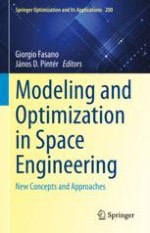2023 | OriginalPaper | Chapter
Second-order Sufficient Conditions of Strong Minimality with applications to Orbital Transfers
Author : Leonardo Mazzini
Published in: Modeling and Optimization in Space Engineering
Publisher: Springer International Publishing
Activate our intelligent search to find suitable subject content or patents.
Select sections of text to find matching patents with Artificial Intelligence. powered by
Select sections of text to find additional relevant content using AI-assisted search. powered by
